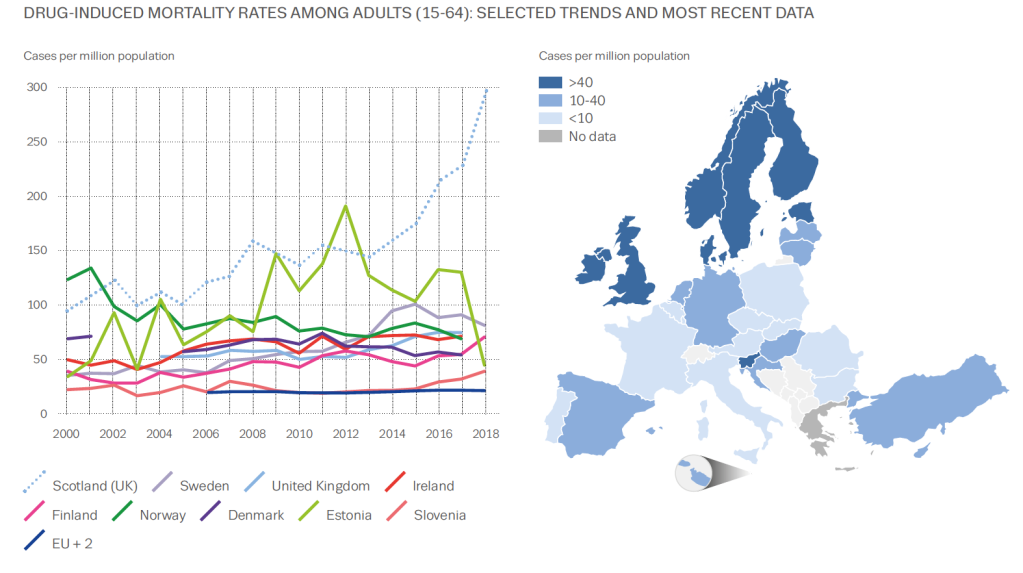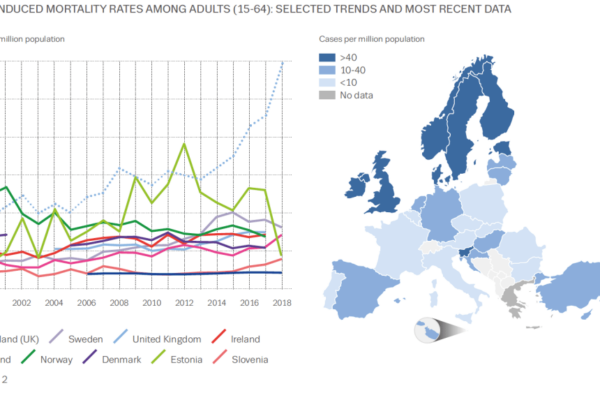 Graphic from European Drug Report 2020: Trends and Developments
Graphic from European Drug Report 2020: Trends and Developments
It’s not often graphs elicit an emotional response, but this one did for me. It’s from the EMCDDA’s recent report on drugs in Europe. The map shows that the UK has high levels of drug-induced mortality compared to most of Europe. But look at the dotted blue line on the graph. That’s Scotland. Worst in Europe and possibly the world.
It’s not a new phenomenon, our high drug-related deaths. The Scottish Drugs Forum makes the point: ‘Drug overdose deaths are preventable. We know how to prevent these deaths and yet they still happen.’
Kindness Compassion and Hope
So what’s being done about it? One of the highest-hit cities is Dundee. A commission set up to look at drug-related deaths took evidence from over 1000 people and made recommendations which included changing the system and culture, having holistic and integrated care and addressing the root causes of drug problems. The report title was Kindness, Compassion and Hope, which feels inspiring.
The Scottish Government has invested in treatment services with a particular emphasis on reaching more at-risk people and retaining them in treatment. Last summer it set up the Drugs Death Task Force, a group chaired by Dr Catriona Mathieson which has highlighted the need for wide distribution of naloxone, an immediate response pathway on non-fatal overdoses, medication assisted treatment (MAT), the targeting of those most at risk, public health surveillance and provision of equity of support for those in the criminal justice system. The Scottish Government has put £1M into research and £4M towards the task force’s six recommendations.
Standards for MAT have been developed, the country has a three week target from referral to treatment, ready access to prescribing, treatment free at the point of delivery, routine overdose prevention training, widespread naloxone distribution, generally accessible injecting equipment provision, low threshold clinics in many places and a high public awareness of the problem. In addition, there is investment in research which looks to find solutions to the problem. But is it enough? – the causes of our drug deaths are complex and rooted in poverty, exclusion, trauma and hopelessness.
A public health emergency
“What we are facing in Scotland is a public health emergency,” Joe Fitzpatrick, Scotland’s Public Health minister stated recently. “I am prepared to consider any course of action that is evidence based to save lives, whether its controversial or unpopular.”
Too controversial for the UK government are drug consumption rooms which Glasgow in particular wants to trial. Drugs policy is not devolved to the Scottish Government and Westminster won’t consider changing the law to allow this to happen, though one crusader is flouting the rules to deliver this currently.
One area in Scotland where consensus is growing is around the likely benefits of shifting to a public health approach. A cross-party parliamentary group, The Scottish Affairs Committee, held an enquiry into the subject and reported at the end of last year. It asked the UK government to declare a public health emergency making the point that the criminal justice approach has failed. It highlighted how current legislation on drugs stands in the way of tackling the issue from a public health slant.
And the UK government’s response? Pete Wishart, the group’s chair described this as ‘the almost wholesale rejection of recommendations.’ The Guardian has suggested this rejection of what multiple experts think is best for Scotland can only fuel calls for independence. When you consider that the UK government hosted a summit in Glasgow last February without consulting the Scottish Government or asking people with lived experience to attend, you begin to grasp the depth of the gulf that separates the two approaches.
The role of visible recovery
I wonder in all of this what the role is for recovering people, recovery communities and the powerful protective effects of developing strong social networks for those most at risk. What if we studied whether developing new social networks had a significant effect on Scottish drug deaths? What if we developed drug consumption rooms which were strongly recovery-orientated with visible recovery present? I suspect, that at the very least, this would boost hope. Hope is often in short supply in addiction, and anything that augments it is welcome.
Perhaps if every outreach service, every injecting equipment outlet and every treatment setting had people with lived experience prioritising the connection of those at most risk not just into treatment but also into a variety of supportive recovery-oriented settings, there could be a positive impact on drug deaths. Perhaps this would help people begin a cultural journey, moving from the culture of addiction to a culture of recovery as Bill White sets out. Not the only thing to be done certainly, our approaches need to be multiple, but something that doesn’t require the permission of the UK Government and which may augment the other interventions.
The Drug Deaths statistics for Scotland for 2019 have been delayed due to COVID, but will be published soon. I’d like to see that dotted blue line on the graph reducing, but that is by no means certain and much remains to be done.
